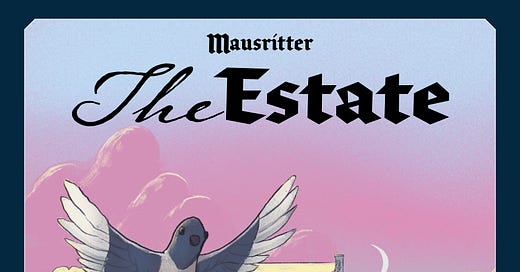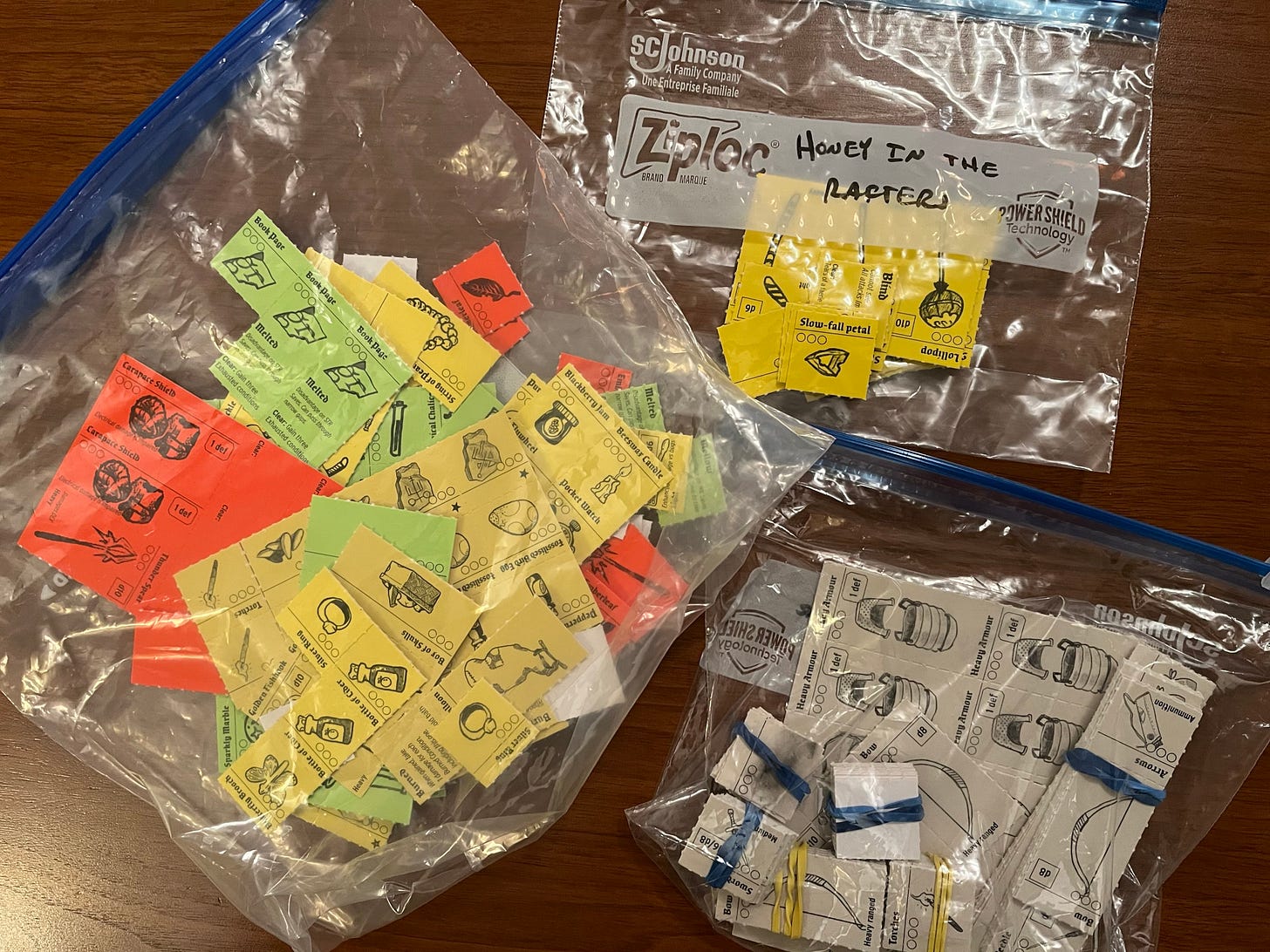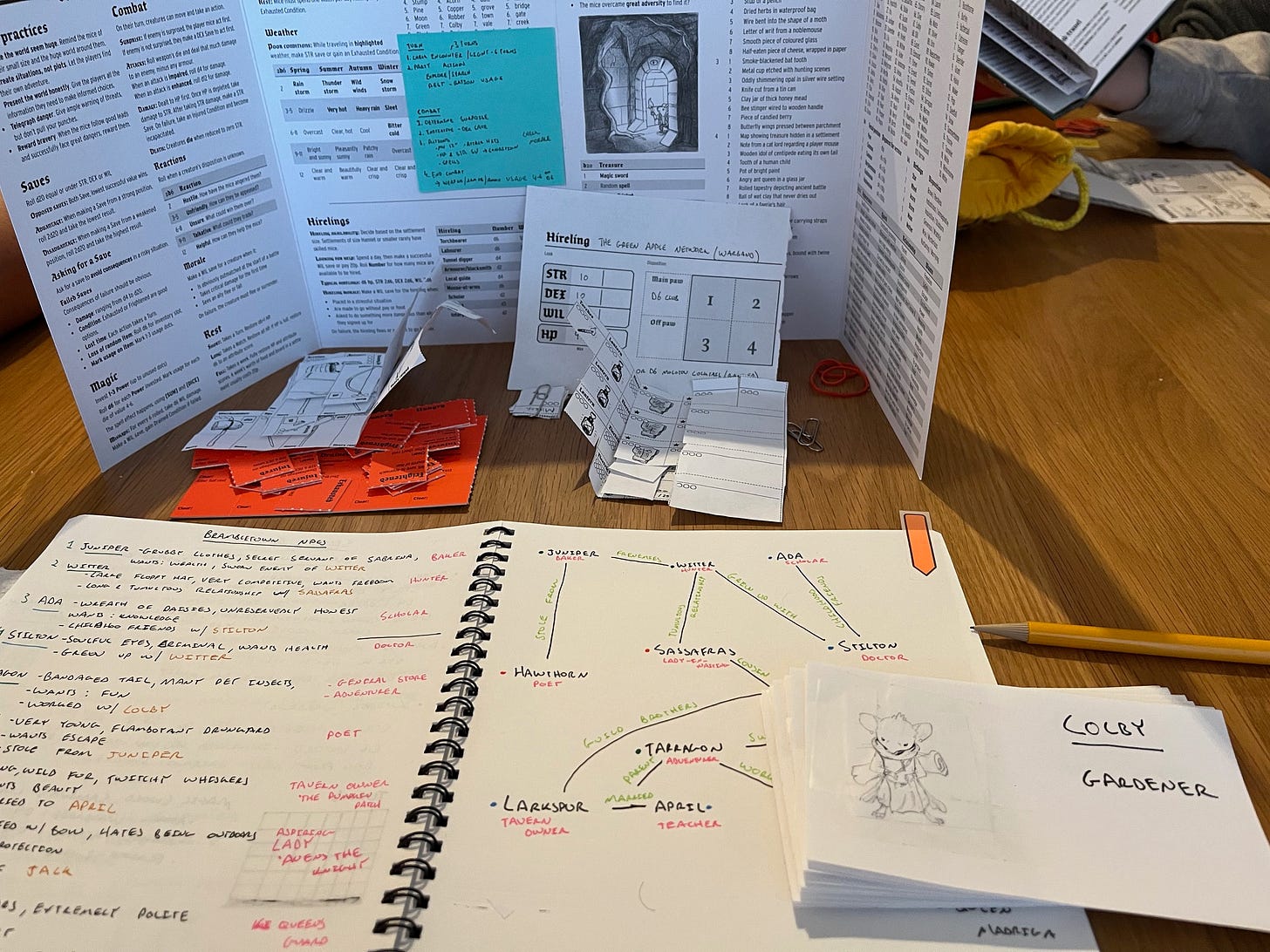I just finished a short, 5-session mini-campaign for my in-person group, running Mausritter and specifically the campaign boxed set called The Estate. Mausritter is a game about brave, heroic adventurer mice in a big, dangerous world, risking life and paw to make that world just a little bit safer for their community. So of course my players were motivated first by sheer greed, then by all-consuming lust for power, culminating in them taking over the humble mouse kingdom of Brambletown, leaving the town in chaos while agreeing to be dark servitors of the cat witch Sabrina.
Spoilers for The Estate below
I jest. Given that the players in my online 5e group are very much goody two-shoes, I appreciated the degeneracy and shenanigans of this group. More to the point, while Mausritter has a cosy and cute theme, it is very much an OSR game. You get experience for treasure, which motivated my players to explore the map and the dungeons therein. Moreover, the game does an excellent job helping the GM manage factions in a sandbox setting, and as the PCs become wealthier they have a significant capacity to recruit hirelings and warbands to help take on those factions. Overall I had a fun and surprising experience running The Estate. Here is my mini-campaign retrospective.
The Product
The Estate is a beautiful and well put-together product. Inside the sturdy box there are eleven colorful tri-fold pamphlet adventures with item and condition cards, as well as a campaign overview booklet. The adventures are written by several prominent OSR designers, and each has an evocative and playful theme. Overall, it’s probably one of the best uses of color in almost any RPG product that I’ve seen.
What happened: A Campaign Report
skip to the next section if you just want to hear my thoughts on The Estate
We played five 3-hour sessions, more or less getting through one adventure per session along with downtime. In total we played through four of the adventures: The Ember Tree by LF OSR, Tower of Soot by Lazy Litch, Fruit of the Orchard by Madeleine Ember, and Science of Sorrow by Nate Treme. I had given them hooks to start for all eleven adventures, and they chose The Ember Tree to start because it seemed like a promising way to make money. They were able to do so in the end, mostly through rescuing a caterpillar nobility, though one mouse was killed by a lightning elemental. They then proceeded to Tower of Soot to rescue another prince (for money), Prince Ansel of Brambletown, which they barely did after navigating various dangers contained within a fireplace. They sought to return Prince Ansel to Brambletown, but found all was not right there, leading to a confrontation with a magpie in Fruit of the Orchard. Through the combination of returning the prince, dealing with this threat, and taking the magpie’s treasure hoard, they managed to get fairly wealthy in this adventure. They proceeded to buy some real estate in the town of Brickport and hire a bunch of mice-at-arms for their next adventure.
Here’s where things got interesting. One, I made up a hook that the bone rats gang was looking to partner with them to smuggle drugs into Brickport, in an effort to put the factions of the adventure more front and center. They decided to take this hook, thus entering their Breaking Bad phase. They navigated Science of Sorrow to find a rat named Two Skulls, and made a deal with him for a supply of some of his chemicals. Then, the group decided that the quaint monarchy of Brambletown had to fall, and they wanted to take over to use the town as a base for their own smuggling operations. This was rather unexpected! But it meant that our final session was spent playing through the attempt to off the rulers of Brambletown.
For the final session, I made up a group of collectivist rebels in Brambletown called The Green Apple Network. Rolling randomly on the Mausritter NPC charts, however, I discovered that the leader of this group was secretly working for Sabrina, the cat witch. I also made up a bunch of other NPCs using those fantastic tables, preparing for what I thought would be an intrigue-filled social crawl.
The pcs decided to go in a different direction, allying both with the magpies faction and with Sabrina to take down Queen Madriga of Brambletown. As a result, a final confrontation played out among these 4 factions and the pcs. Basically it became a multi-directional war with the PCs trying in real time to keep playing factions off each other for the sake of their own survival. Astonishingly, it worked! I kept trying to think of ways to have one of the warband-scale participants off the pcs, but every time I considered their motives, there was always someone else that was better to attack. I let the players take turns controlling the faction actions and take over some of the dice-rolling.
In the epilogue, one mouse decided to leave the Estate, living a life of regret. The other three mice decided to being servants of Sabrina as a path of attaining more magic and power. They took the Ember Tree as their home base. After this war, the balance of power in the Estate thus swung toward Sabrina, inaugurating her dark reign. Cosy!
Thoughts on Mausritter and The Estate
Tactile, but lots of bits
In Mausritter, your inventory comes in the form of small cards that you place physically on your character sheet. Conditions, too, are small cards that take up inventory slots. I love this tactile element to the game and simple approach to having a limited inventory. It makes the six slots you do have in your inventory super important and tactically limiting without being complicated to track. On the other hand, once we started playing item and condition cards started flying back and forth across the table, and I soon had a little, increasingly chaotic pile of them in front of me. The fact that each adventure came with its own bespoke card of items and conditions only added to the chaos of this pile. I think some people do make organizers for all these cards; for me, I just resorted to tossing everything in a series of ziplock bags. If I ever replay these modules with a different group I’ll have to sort it all out then.
Theme
As mentioned above, the adventures in the estate each have a unique and evocative theme. I did learn that I prefer low fantasy mice gaming. In this game, you inhabit a world where ordinary animals talk, wield weapons, and cast spells. Mice are adventurers and cats are like dragons, and this fact escapes the notice of the oblivious humans. That’s fantastical enough for me. I preferred the adventures that kept their expression of this fantasy world more straight-forward. The adventures that were more high fantasy were not only less to my liking, but threw me for a loop, in a way that they might not have in a more traditional game. Simple things: like, the setting of The Ember Tree is a tree perpetually on fire…but wouldn’t the humans notice that?
Interactivity
Being confined to the front and back of a tri-fold pamphlet, these adventures are very brief. These are essentially one page dungeons, with space for only a few succinct bullet points per room. I discuss this dynamic further here, but what this led to was a different expectation on how to think about interactivity in an adventure module. Compare these tri-fold adventures to the longer dungeons published by Necrotic Gnome, like The Hole in the Oak. Those adventures, too, feature an efficient layout of room description, making use of bullet points and bolding to help the GM run the scenario at the table. Yet, each room might be allotted half an A5 page; this is enough space for the author to include several interactive elements per room, sometimes elements that are in interesting tension with each other. The tri-fold adventure, on the other hand, only has space for each room or area to have one ‘thing’ going on. It takes a lot of skill to present an interesting challenge to the player in such little space, and the adventures were uneven in how they accomplished that.
However, some of the adventures do feature more interactivity at the scale of the entire scenario. That is, the key to resolving an encounter in one area might be located in a different area, thus affecting the way that the PCs engage with the scenario as a whole. The campaign booklet for The Estate does the additional work to tie the scenarios together in this way, such that treasures or information that might be helpful in one adventure are to be located in a separate adventure, leading potentially to the PCs traversing back and forth across the map to achieve their goals. This makes the sandbox nature of the campaign much more dynamic; it’s not simply a matter of choosing and then playing through scenario A or scenario B, but seeing how these scenarios are interlinked. Granted I think the results are mixed; some of the interconnections are weak or hard to telegraph, but I appreciate that the effort was taken to stitch these separately-written modules together into something more cohesive.
Usability
The compactness of these adventures in general made them extremely usable at the table. I did read through all of them before starting the campaign, but didn’t necessarily memorize them. I was able to pull the pamphlets out based on what the PCs choose to do, and in general I could quickly scan the summary and bullet points to jog my memory of what was going on.
In general. There were places where the brevity of description got the better of me. This wasn’t so much when the brief description led me to improvise room or area details, NPC names and personalities, or anything like that. That’s all fine and was easy enough to do. But there were places where the module writers definitely had a lot more that they wanted to say than they had space.
Tower of Soot by Lazy Litch was the most difficult here. On the surface, this module is about rescuing a mouse from a cage. But they add to that a slightly forced escape through a chimney, a chimney whose map was (to me) complicated because it seemed to be illustrating both the chimney’s interior and exterior with unclear connections between some locations, and an area that had a subspace requiring a separate mini-map. There was also a timer of events instead of a normal encounter table. Finally, the scenario had a whole subplot revolving around some creatures made of soot: a soot-king that had been displaced for some reason, a crown that was in the possession of a random centipede for some reason, and soot-ghosts there were angry for some reason. The reasons for this whole mini-drama had to be supplied by me, the GM, and because of my own lack of preparation I had to do this on the spot as my players asked me question after very-reasonable question as to what the hell was going on with these soot-people. This is really when the brevity of these modules gets in the way of running them. A GM improvising room details is one thing, but having to interpret a complicated subplot based on fragmentary clues, and doing so in real time, was difficult for me.
Density of adventure sites and faction play
The Mausritter rulebook suggests 2-4 adventure sites per ‘hex flower’ of 19 hexes, yet The Estate has eleven adventure sites. As mentioned, I initially gave my players hooks for all eleven adventures, on the idea that they could choose which hook to pursue and that all the material was in this way made available to them. However, in retrospect I think I would start with hooks to only a few adventure sites, and might even run the campaign excising half of the sites. As it was, we only got through four adventures.
If I run this again, the adventures I would be sure to include would be Fruit of the Orchard, The Ticking Tower by Josiah S Moore, The Chapel of Eternal Peace by Diogo Nogueira, and maybe Giant Snake is in the Sewer by gnarledmonster, only because those four deal with the factions outlined in the campaign booklet. In addition to that, Science of Sorrow was a fun adventure, and I am drawn to Workers Work, Rulers Rule by Skullfungus and The Wizard of Arms and Armour by Amanda Lee Franck; NPCs from those adventures could easily be factions as well.
Even though some of those adventures touch on the factions listed in the campaign booklet, only one (The Ticking Tower) details the lair of one of the named factions. In fact, though Mausritter’s faction system is extremely elegant, I found that The Estate largely leaves the process of presenting factions to the players in meaningful ways to the GM. The lairs of Sabrina the cat and the magpies are not detailed, and the bone rats gang, while mentioned often, have only a lair that is deeply compromised if not completely taken over by a snake. Meanwhile, several of the other adventures do have interesting NPCs that could serve as good antagonists (or allies), but we don’t get faction goals for them. I found this to be an odd choice; if I were making my own Mausritter campaign, I would make at least half the adventure sites lairs for the various factions.
All that being said, however, I was pleasantly surprised at how quickly the campaign launched itself into faction/domain-play territory. This was undoubtedly part due to my ambitious and power-hungry players, who were not content to just play through each pamphlet adventure, but wanted to make serious plays to take over part of the estate map. The default prices for hirelings were barely an inconvenience given how much wealth they quickly accumulated; the more serious barrier was just finding enough hirelings (per the rules for finding hirelings, you can often only find d6 or fewer of the kind that you want). One lucky roll meant that they entered Science of Sorrow with six mice at arms and one knight, in addition to a guide and two torchbearers. Yes, some of these died, but honestly that group could have made short work of that whole dungeon, had they wanted to. (By the way, for this reason I recommend using Electric Bastionland’s rule for group attacks, in which when several characters attack the same creature, you only take the highest damage roll.) Moreover, even by level 2, they had enough money to hire a warband.
Together, this really felt like how people describe playing OD&D—as a little wargame in which a retinue of hirelings and retainers are led by the adventurer PCs in the search of greater domains. Yet, the Mausritter/Into the Odd system for hirelings and warbands, including warband-scale creatures, made this process more seamless and elegant (granted, the bringing of 10 hirelings into the dungeon did lead to a lot of rolling, even with no attack rolls). Due to both their own tastes and the incentives of the system, the four adventurer-mice quickly surrounded themselves with larger and larger entourages (through hire and alliance), and directed those resources toward waging a complex all-out war, all for the sake of expanding their domain and influence.
Mausritter, the wargame!
Final thoughts
Overall, I had a great time playing The Estate and Mausritter in general. What was especially pleasing was the way that Mausritter hit all of the keynotes of OSR play: a deadly and dangerous start, the acquisition of treasure and hooks into a setting, culminating with the leveraging of that treasure to obtain a domain via warfare.
In terms of The Estate specifically, despite some of the above problems, the adventures on the whole are interesting, creative, and playful. So if the campaign looks appealing to you, I would pick it up.
That said, I think I would have had an equal amount of fun making my own campaign and my own adventures. I’d be able to tailor such a campaign to my preferences, for example by keeping the theme low fantasy and focusing from the start on the faction play. And however brief I wrote the adventure sites, I would be able to fill in the blanks at the table, because they would be my own ideas. So if you are interested in Mausritter, don’t feel like you have to buy The Estate. The core Mausritter book is free, and the website has all the printable sheets and resources for making your own items, conditions and adventures.









This is a great round-up. Makes me want to follow on with my own review (I also ran a semi-open table that did some cool faction/campaign stuff with about 8 of the adventures). I did find, though, that once I finished it, I found myself... fairly done with Mausritter. My players had sort of "gotten" the style of adventure site, 5-room-dungeon play and had their fun with it.
Do you find you still want to return to Mausritter for future campaigns?
After .y players defeated the snake quickly i started using EB's group attacks rule. Players still ganged up on mobs though instead of doing trickery. We ended with the group gathering allies (6 warbands) and taking on Sabrina. It was a blast!